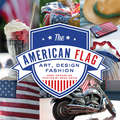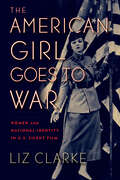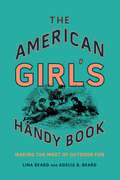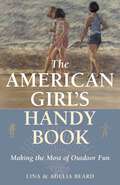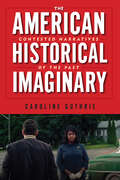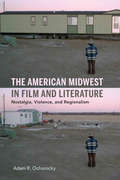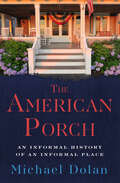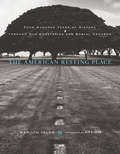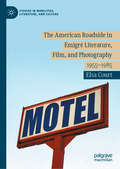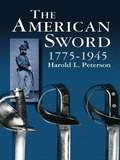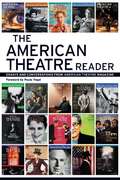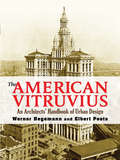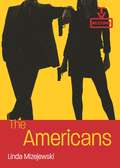- Table View
- List View
The American Flag: Art, Design, Fashion
by Mary EmmerlingFrom the author of Eclectic Country, a patriotic collection of 200 artists&’ and designers&’ renditions of the American flag. Flags are so everywhere, so ever-present that we often barely notice them. But focused through a collector&’s vision and a photographer&’s eye, the good old red, white, and blue brings a smile, a memory, a tear and a lump to our throats. The flag is more than a symbol; it is art, and here are 200 artists&’ and designers&’ renditions of the ultimate symbol of freedom.
The American Girl Goes to War: Women and National Identity in U.S. Silent Film (War Culture)
by Liz ClarkeDuring the 1910s, films about war often featured a female protagonist. The films portrayed women as spies, cross-dressing soldiers, and athletic defenders of their homes—roles typically reserved for men and that contradicted gendered-expectations of home-front women waiting for their husbands, sons, and brothers to return from battle. The representation of American martial spirit—particularly in the form of heroines—has a rich history in film in the years just prior to the American entry into World War I. The American Girl Goes to War demonstrates the predominance of heroic female characters in in early narrative films about war from 1908 to 1919. American Girls were filled with the military spirit of their forefathers and became one of the major ways that American women’s changing political involvement, independence, and active natures were contained by and subsumed into pre-existing American ideologies.
The American Girl's Handy Book: Making the Most of Outdoor Fun
by Adelia B. Beard Lina BeardEach summer, millions of children complain, "There's nothing to do." Originally published in 1889, The American Girl's Handy Book resoundingly challenges this age-old dilemma by providing a huge number of ideas for fun and instructional projects for young girls. It includes plans for April Fool's parties and jokes, transplanting wildflowers and preserving or pressing them, Easter games and activities, instructions for making a lawn tennis net and the rules of the game, how to make a hammock, corn husk and flower dolls, instructions for making various fans, Halloween parties, making a telephone, painting in water or oil colors, making models in clay and wax, making picture frames, and suggestions for winter games and activities! As with its companion, The American Boy's Handy Book, the girl's book is divided into seasons ensuring fun will be had all year round.
The American Girl's Handy Book: Making the Most of Outdoor Fun
by Adelia B. Beard Lina BeardEach summer, millions of children complain, "There's nothing to do." Originally published in 1889, The American Girl's Handy Book resoundingly challenges this age-old dilemma by providing a huge number of ideas for fun and instructional projects for young girls. It includes plans for April Fool's parties and jokes, transplanting wildflowers and preserving or pressing them, Easter games and activities, instructions for making a lawn tennis net and the rules of the game, how to make a hammock, corn husk and flower dolls, instructions for making various fans, Halloween parties, making a telephone, painting in water or oil colors, making models in clay and wax, making picture frames, and suggestions for winter games and activities! As with its companion, The American Boy's Handy Book, the girl's book is divided into seasons ensuring fun will be had all year round.
The American Historical Imaginary: Contested Narratives of the Past
by Caroline GuthrieIn The American Historical Imaginary: Contested Narratives of the Past in Mass Culture Caroline Guthrie examines the American relationship to versions of the past that are known to be untrue and asks why do these myths persist, and why do so many people hold them so dear? To answer these questions, she examines popular sites where fictional versions of history are formed, played through, and solidified. From television’s reality show winners and time travelers, to the Magic Kingdom in Walt Disney World, to the movies of Quentin Tarantino, this book examines how mass culture imagines and reimagines the most controversial and painful parts of American history. In doing so, Guthrie explores how contemporary ideas of national identity are tied to particular versions of history that valorize white masculinity and ignores oppression and resistance. Through her explanation and analysis of what she calls the historical imaginary, Guthrie offers new ways of attempting to combat harmful myths of the past through the imaginative engagements they have dominated for so long.
The American History Highway: A Guide to Internet Resources on U.S., Canadian, and Latin American History (History Highway Ser.)
by Dennis A. TrinkleThis brand new addition to the acclaimed "History Highway" series is essential for anyone conducting historical research on North, Central, or South America. Complete with a CD with live links to sites, it directs users to the best and broadest, most current information on U.S., Canadian, and Latin American history available on the Internet. "The American History Highway": provides detailed, easy-to-use information on more than 1,700 websites; covers all periods of U.S., Canadian, and Latin American History; features new coverage of Hispanic American and Asian American History; includes chapters on environmental history, immigration history, and document collections; all site information is current and up-to-date; includes a CD of the entire contents with live links to sites - just install the disc, go online, and link directly to the sites; and, also provides a practical introduction to web-based research for students and history buffs of all ages.
The American Idea of Home: Conversations about Architecture and Design
by Bernard Friedman“Home is an idea,” Meghan Daum writes in her foreword, “a story we tell ourselves about who we are and who and what we want closest in our midst.” In The American Idea of Home, documentary filmmaker Bernard Friedman interviews more than thirty leaders in the field of architecture about a constellation of ideas relating to housing and home. The interviewees include Pritzker Prize winners Thom Mayne, Richard Meier, and Robert Venturi; Pulitzer Prize winners Paul Goldberger and Tracy Kidder; American Institute of Architects head Robert Ivy; and legendary architects such as Denise Scott Brown, Charles Gwathmey, Kenneth Frampton, and Robert A. M. Stern. The American idea of home and the many types of housing that embody it launch lively, wide-ranging conversations about some of the most vital and important issues in architecture today. The topics that Friedman and his interviewees discuss illuminate five overarching themes: the functions and meanings of home; history, tradition, and change in residential architecture; activism, sustainability, and the environment; cities, suburbs, and regions; and technology, innovation, and materials. Friedman frames the interviews with an extended introduction that highlights these themes and helps readers appreciate the common concerns that underlie projects as disparate as Katrina cottages and Frank Lloyd Wright Usonian houses. Readers will come away from these thought-provoking interviews with an enhanced awareness of the “under the hood” kinds of design decisions that fundamentally shape our ideas of home and the dwellings in which we live.
The American Idea of Home: Conversations about Architecture and Design
by Bernard FriedmanOver thirty leaders in American architecture discuss the most significant issues in the field today.&“Home is an idea,&” Meghan Daum writes in her foreword, &“a story we tell ourselves about who we are and who and what we want closest in our midst.&” In The American Idea of Home, documentary filmmaker Bernard Friedman interviews more than thirty leaders in the field of architecture about a constellation of ideas relating to housing and home. The interviewees include Pritzker Prize winners Thom Mayne, Richard Meier, and Robert Venturi; Pulitzer Prize winners Paul Goldberger and Tracy Kidder; American Institute of Architects head Robert Ivy; and legendary architects such as Denise Scott Brown, Charles Gwathmey, Kenneth Frampton, and Robert A. M. Stern. The American idea of home and the many types of housing that embody it launch lively, wide-ranging conversations about some of the most vital and important issues in architecture today. The topics that Friedman and his interviewees discuss illuminate five overarching themes: the functions and meanings of home; history, tradition, and change in residential architecture; activism, sustainability, and the environment; cities, suburbs, and regions; and technology, innovation, and materials. Friedman frames the interviews with an extended introduction that highlights these themes and helps readers appreciate the common concerns that underlie projects as disparate as Katrina cottages and Frank Lloyd Wright Usonian houses. Readers will come away from these thought-provoking interviews with an enhanced awareness of the &“under the hood&” kinds of design decisions that fundamentally shape our ideas of home and the dwellings in which we live.
The American Jewish Story Through Cinema (Jewish Life, History, and Culture)
by Eric A. GoldmanLike the haggadah, the traditional “telling” of the story of the Israelites’ exodus from Egypt that is read at the Passover seder, cinema offers a valuable text from which to gain an understanding of the social, political, and cultural realities of Jews in America. In an industry strongly influenced by Jewish filmmakers who made and continue to make the decisions as to which films are produced, the complex and evolving nature of the American Jewish condition has had considerable impact on American cinema and, in particular, on how Jews are reflected on the screen. This groundbreaking study analyzes select mainstream films from the beginning of the sound era to today to provide an understanding of the American Jewish experience over the last century. In the first half of the twentieth century, Hollywood’s movie moguls, most of whom were Jewish, shied away from asserting a Jewish image on the screen for fear that they might be too closely identified with that representation. Over the next two decades, Jewish moviemakers became more comfortable with the concept of a Jewish hero and with an overpowered, yet heroic, Israel. In time, the Holocaust assumed center stage as the single event with the greatest effect on American Jewish identity. Recently, as American Jewish screenwriters, directors, and producers have become increasingly comfortable with their heritage, we are seeing an unprecedented number of movies that spotlight Jewish protagonists, experiences, and challenges.
The American Jewish Story through Cinema (Jewish Life, History, and Culture)
by Eric A. GoldmanLike the haggadah, the traditional “telling” of the story of the Israelites’ exodus from Egypt that is read at the Passover seder, cinema offers a valuable text from which to gain an understanding of the social, political, and cultural realities of Jews in America. In an industry strongly influenced by Jewish filmmakers who made and continue to make the decisions as to which films are produced, the complex and evolving nature of the American Jewish condition has had considerable impact on American cinema and, in particular, on how Jews are reflected on the screen. This groundbreaking study analyzes select mainstream films from the beginning of the sound era to today to provide an understanding of the American Jewish experience over the last century. In the first half of the twentieth century, Hollywood’s movie moguls, most of whom were Jewish, shied away from asserting a Jewish image on the screen for fear that they might be too closely identified with that representation. Over the next two decades, Jewish moviemakers became more comfortable with the concept of a Jewish hero and with an overpowered, yet heroic, Israel. In time, the Holocaust assumed center stage as the single event with the greatest effect on American Jewish identity. Recently, as American Jewish screenwriters, directors, and producers have become increasingly comfortable with their heritage, we are seeing an unprecedented number of movies that spotlight Jewish protagonists, experiences, and challenges.
The American Midwest in Film and Literature: Nostalgia, Violence, and Regionalism
by Adam R. OchonickyHow do works from film and literature—Sister Carrie, Native Son, Meet Me in St. Louis, Halloween, and A History of Violence, for example—imagine, reify, and reproduce Midwestern identity? And what are the repercussions of such regional narratives and images circulating in American culture? In The American Midwest in Film and Literature: Nostalgia, Violence, and Regionalism, Adam R. Ochonicky provides a critical overview of the evolution, contestation, and fragmentation of the Midwest's symbolic and often contradictory meanings. Using the frontier writings of Frederick Jackson Turner as a starting point, this book establishes a succession of Midwestern filmic and literary texts stretching from the late-19th century through the beginning of the 21st century and argues that the manifold properties of nostalgia have continually transformed popular understandings and ideological uses of the Midwest's place-identity. Ochonicky identifies three primary modes of nostalgia at play across a set of textual objects: the projection of nostalgia onto physical landscapes and into the cultural sphere (nostalgic spatiality); nostalgia as a cultural force that regulates behaviors, identities, and appearances (nostalgic violence); and the progressive potential of nostalgia to generate an acknowledgment and possible rectification of ways in which the flawed past negatively affects the present (nostalgic atonement). While developing these new conceptions of nostalgia, Ochonicky reveals how an under-examined area of regional study has received critical attention throughout the histories of American film and literature, as well as in related materials and discourses. From the closing of the Western frontier to the polarized political and cultural climate of the 21st century, this book demonstrates how film and literature have been and continue to be vital forums for illuminating the complex interplay of regionalism and nostalgia.
The American Midwest in Film and Literature: Nostalgia, Violence, and Regionalism
by Adam R. OchonickyA critical overview of the evolution, contestation, and fragmentation of the Midwest’s symbolic (and often contradictory) meanings in American culture.How do works from film and literature—Sister Carrie, Native Son, Meet Me in St. Louis, Halloween, and A History of Violence, for example—imagine, reify, and reproduce Midwestern identity? And what are the repercussions of such regional narratives and images circulating in American culture? In The American Midwest in Film and Literature: Nostalgia, Violence, and Regionalism, Adam R. Ochonicky provides a critical overview of the evolution, contestation, and fragmentation of the Midwest’s symbolic and often contradictory meanings.Using the frontier writings of Frederick Jackson Turner as a starting point, this book establishes a succession of Midwestern filmic and literary texts stretching from the late-19th century through the beginning of the 21st century and argues that the manifold properties of nostalgia have continually transformed popular understandings and ideological uses of the Midwest’s place-identity. Ochonicky identifies three primary modes of nostalgia at play across a set of textual objects: the projection of nostalgia onto physical landscapes and into the cultural sphere (nostalgic spatiality); nostalgia as a cultural force that regulates behaviors, identities, and appearances (nostalgic violence); and the progressive potential of nostalgia to generate an acknowledgment and possible rectification of ways in which the flawed past negatively affects the present (nostalgic atonement). While developing these new conceptions of nostalgia, Ochonicky reveals how an under-examined area of regional study has received critical attention throughout the histories of American film and literature, as well as in related materials and discourses. From the closing of the Western frontier to the polarized political and cultural climate of the 21st century, this book demonstrates how film and literature have been and continue to be vital forums for illuminating the complex interplay of regionalism and nostalgia.“Ochonicky presents an important reading of how nostalgia shapes the Midwest in the American imagination as a place of identity and violence. Past and present slip in this compelling and well-researched approach to the workings of contemporary culture.” —Vera Dika, author of Recycled Culture in Contemporary Art and Film: The Use of Nostalgia“By centering the concept of region, Adam Ochonicky provides an insightful and refreshing reading of American popular culture. In texts ranging from Richard Wright’s Native Son to John Carpenter’s Halloween, Ochonicky demonstrates the complex terrain of the Midwest in our cultural imaginary and the diverse memories and meanings we project upon it.” —Kendall R. Phillips, author of A Place of Darkness: The Rhetoric of Horror in Early American Cinema, Syracuse University
The American Museum of Natural History and How It Got That Way: With a New Preface by the Author and a New Foreword by Neil deGrasse Tyson
by Colin DaveyThe American Museum of Natural History is one of New York City’s most beloved institutions, and one of the largest, most celebrated museums in the world. Since 1869, generations of New Yorkers and tourists of all ages have been educated and entertained here. Located across from Central Park, the sprawling structure, spanning four city blocks, is a fascinating conglomeration of many buildings of diverse architectural styles built over a period of 150 years. The first book to tell the history of the museum from the point of view of these buildings, including the planned Gilder Center, The American Museum of Natural History and How It Got That Way contextualizes them within New York and American history and the history of science. Part II, “The Heavens in the Attic,” is the first detailed history of the Hayden Planetarium, from the museum’s earliest astronomy exhibits, to Clyde Fisher and the original planetarium, to Neil deGrasse Tyson and the Rose Center for Earth and Space, and it features a photographic tour through the original Hayden Planetarium. Author Colin Davey spent much of his childhood literally and figuratively lost in the museum’s labyrinthine hallways. The museum grew in fits and starts according to the vicissitudes of backroom deals, personal agendas, two world wars, the Great Depression, and the Cold War. Chronicling its evolution―from the selection of a desolate, rocky, hilly, swampy site, known as Manhattan Square to the present day―the book includes some of the most important and colorful characters in the city’s history, including the notoriously corrupt and powerful “Boss” Tweed, “Father of New York City” Andrew Haswell Green, and twentieth-century powerbroker and master builder Robert Moses; museum presidents Morris K. Jesup, Henry Fairfield Osborn, and Ellen Futter; and American presidents, polar and African explorers, dinosaur hunters, and German rocket scientists. Richly illustrated with period photos, The American Museum of Natural History and How It Got That Way is based on deep archival research and interviews.
The American Musical: Evolution of an Art Form
by Ben WestThe American Musical is a comprehensive history of an American art form. It delivers a detailed and definitive portrait of the American musical’s artistic evolution over the course of seven distinct, newly defined eras, with a unique perspective gleaned from research at more than twenty different archives across the United States.Individual in both its approach and coverage, The American Musical traces the form’s creative journey from its 19th century beginnings, through its 20th century maturation, and to the turn of the 21st century, shedding new light on a myriad of authors, directors, and craftspeople who worked on Broadway and beyond. This book actively addresses the form’s often overlooked female and African-American artists, provides an in-depth accounting of such outside influences as minstrelsy, vaudeville, nightclubs, and burlesque, and explores the dynamic relationship between the form and the consciousness of its country.The American Musical is a fascinating and insightful read for students, artists, and afficionados of the American musical, and anyone with an interest in this singular form of entertainment.
The American Porch: An Informal History of an Informal Place
by Michael DolanThe former American History editor explores the creation and restoration of an essential part of a twentieth-century home&’s identity—the American porch. &“In this delightful look at an American icon, journalist and documentary scriptwriter . . . Dolan traces the history of the porch, using this history to explore subjects such as architecture, history, slavery, colonialism, trade, anthropology, sociology, consumer behavior, and publishing.&” —Library Journal In 1981, Michael Dolan and his wife, Eileen O&’Toole, bought a 1926 suburban bungalow in the Palisades area of Washington, DC. It was a fixer-upper and DIY project that consumed their lives for twelve years. As rooms were transformed with updated electrical wiring and plumbing, the house&’s porch became a storage area, rotating appliances, furniture, and construction materials as they were used and discarded. After the interior renovation was completed, Michael finally turned his attention to the porch, working with contractors to resurrect it—a reconstruction that inspired him to uncover the history of porches and their significance as a symbolic piece of Americana. &“In praise of the porch: Come up and sit a spell.&” —USA Today &“A wry, well-researched look at the place and the people who rocked, talked and courted on [the American porch] for three centuries.&” —Parade &“The porch is making a comeback, gradually replacing its humbler rival the deck, which the traditionalist Dolan refers to as the platform shoe or leisure suit of American architecture.&” —Time &“Dolan amply demonstrates that the porch is primarily a means of escaping the heat and, almost as important, a locus for casual social interaction.&” —Publishers Weekly
The American Resting Place: Four Hundred Years of History through Our Cemeteries and Burial Grounds
by Marilyn YalomAn illustrated cultural history of America through the lens of its gravestones and burial practices—featuring eighty black-and-white photographs.In The American Resting Place, cultural historian Marilyn Yalom and her son, photographer Reid Yalom, visit more than 250 cemeteries across the United States. Following a coast-to-coast trajectory that mirrors the historical pattern of American migration, their destinations highlight America’s cultural and ethnic diversity as well as the evolution of burials rites over the centuries.Yalom’s incisive reading of gravestone inscriptions reveals changing ideas about death and personal identity, as well as how class and gender play out in stone. Rich particulars include the story of one seventeenth-century Bostonian who amassed a thousand pairs of gloves in his funeral-going lifetime, the unique burial rites and funerary symbols found in today’s Native American cultures, and a “lost” Czech community brought uncannily to life in Chicago’s Bohemian National Columbarium.From fascinating past to startling future—DVDs embedded in tombstones, “green” burials, and “the new aesthetic of death”—The American Resting Place is the definitive history of the American cemetery.
The American Roadside in Émigré Literature, Film, and Photography: 1955–1985 (Studies in Mobilities, Literature, and Culture)
by Elsa CourtThe American Roadside in Émigré Literature, Film, and Photography: 1955–1985 traces the origin of a postmodern iconography of mobile consumption equating roadside America with an authentic experience of the United States through the postwar road narrative, a narrative which, Elsa Court argues, has been shaped by and through white male émigré narratives of the American road, in both literature and visual culture. While stressing that these narratives are limited in their understanding of the processes of exclusion and unequal flux in experiences of modern automobility, the book works through four case studies in the American works of European-born authors Vladimir Nabokov, Robert Frank, Alfred Hitchcock, and Wim Wenders to unveil an early phenomenology of the postwar American highway, one that anticipates the works of late-twentieth-century spatial theorists Jean Baudrillard, Michel Foucault, and Marc Augé and sketches a postmodern aesthetic of western mobility and consumption that has become synonymous with contemporary America.
The American Southern Gothic on Screen (Horror and Gothic Media Cultures)
by Karen HorsleyThe Southern Gothic on Screen explores a body of screen texts that conform to certain generic conventions and aesthetics that, since the early twentieth century, have led to the construction of the American South as a space of ruin, decay, melancholy, loss, and haunting. The book considers the cultural significance of the Southern Gothic on screen by examining southern otherness as the primary mechanism through which the South is rendered a space of darkness and danger. This opens up a critical space for the Southern Gothic to be discussed as a screen genre with its own complex visual, thematic and narrative codes. The book establishes a perspective that synthesizes a broad understanding of Southern Gothic genericity with pre-existing cultural and political discourses on the South, resulting in an analysis that is specific to film and television while remaining heedful of the intersecting discourses that inform both the Gothic and the South as historic and mediated constructs.
The American Stamp: Postal Iconography, Democratic Citizenship, and Consumerism in the United States
by Richard Handler Laura GoldblattMore than three thousand different images appeared on United States postage stamps from the middle of the nineteenth century to the end of the twentieth. Limited at first to the depiction of a small cast of characters and patriotic images, postal iconography gradually expanded as the Postal Service sought to depict the country’s history in all its diversity. This vast breadth has helped make stamp collecting a widespread hobby and made stamps into consumer goods in their own right.Examining the canon of nineteenth- and twentieth-century American stamps, Laura Goldblatt and Richard Handler show how postal iconography and material culture offer a window into the contested meanings and responsibilities of U.S. citizenship. They argue that postage stamps, which are both devices to pay for a government service and purchasable items themselves, embody a crucial tension: is democracy defined by political agency or the freedom to buy? The changing images and uses of stamps reveal how governmental authorities have attempted to navigate between public service and businesslike efficiency, belonging and exclusion, citizenship and consumerism. Stamps are vehicles for state messaging, and what they depict is tied up with broader questions of what it means to be American.Goldblatt and Handler combine historical, sociological, and iconographic analysis of a vast quantity of stamps with anthropological exploration of how postal customers and stamp collectors behave. At the crossroads of several disciplines, this book casts the symbolic and material meanings of stamps in a wholly new light.
The American Sword 1775-1945
by Harold L. PetersonThe first book devoted exclusively to the subject, this invaluable volume will aid collectors, curators, historians. Enhanced with more than 400 illustrations from rare documents, the book classifies and describes all major types of swords worn by the U.S. armed forces, cadets, and diplomats since the American Revolution to the end of World War II.
The American Theatre Reader
by Staff of American Theatre MagazineIn celebration of American Theatre's twenty-fifth anniversary, the editors of the nation's leading theater magazine have chosen their best essays and interviews to provide an intimate look at the people, plays, and events that have shaped the American theater over the past quarter-century. Over two hundred artists, critics, and theater professionals are gathered in this one-of-a-kind collection, from the visionaries who conceived of a diverse and thriving national theater community, to the practitioners who have made that dream a reality. The American Theatre Reader captures their wide-ranging stories in a single compelling volume, essential reading for theater professionals and theatergoers alike.Partial contents include:Interviews with Edward Albee, Anne Bogart, Peter Brook, Lorraine Hansbury, Lillian Hellman, Jonathan Larson, David Mamet, Arthur Miller, Joseph Papp, Will Power, Bartlett Scher, Sam Shepard, Tom Stoppard, Luis Valdez, Paula Vogel, August Wilson, and others.Essays by Eric Bentley, Eric Bogosian, Robert Brustein, Christopher Durang, Oskar Eustis, Zelda Fichandler, Eva La Gallienne, Vaclav Havel, Danny Hoch, Tina Howe, David Henry Hwang, Naomi Iizuki, Adrienne Kennedy, Tony Kushner, Kristin Linklater, Todd London, Robert MacNeil, Des McAnuff, Conor McPherson, Marsha Norman, Suzan-Lori Parks, Hal Prince, Phylicia Rashad, Frank Rich, José Rivera, Alan Schneider, Marian Seldes, Wallace Shawn, Anna Deavere Smith, Molly Smith, Diana Son, Wole Soyinka, and many others.
The American Vignola: A Guide to the Making of Classical Architecture
by William R. Ware"Vignola codified the rules of classical architecture for the Italian Renaissance . . . Ware codified Vignola for the American Renaissance." -- John Barrington Bayley, from the Introductory Notes to The American Vignola.From 1890 to 1940, Americans designed and built classical architecture on an extraordinary scale. During this American Renaissance were built countless libraries, museums, universities, courthouses, capitol buildings and other structures, both public and private, rich with domes, pediments, colonnades, and other classical features. "We built with unparalleled grandeur," architect and scholar John Barrington Bayley observes, "and our architecture led the world." More than any other document of the period, The American Vignola laid the groundwork for this grand resurgence in American architecture. Its author, William R. Ware, founded America's first school of architecture at M.I.T. in 1865, and sixteen years later, the School of Architecture at Columbia University. He became America's leading teacher of the art of designing classical architecture. The American Vignola is his textbook on that art. As the Renaissance architect Giacomo Barozzi da Vignola helped to recover the lost laws of classical architecture that made possible the architectural wonders of the Italian Renaissance, Ware helped lay the groundwork for the wonders of the American Renaissance. The American Vignola contains tables of the Tuscan, Ionic, Doric, Corinthian, and Composite Orders; measured drawings of the great monuments of the ancient, Renaissance, and baroque periods; and guides for drawing and establishing geometrical relations. Especially important are its detailed practical instructions for designing classical arches and vaults, roofs and domes, doors and windows, walls and ceilings, steps and staircases, and more. Over 300 illustrations illuminate the text, including 37 full-page plates and 267 smaller figures. Introductory notes by Mr. Bayley and architectural expert Henry Hope Reed set Mr. Ware's great achievement in perspective.
The American Vitruvius: An Architects' Handbook of Urban Design
by Werner Hegemann Elbert PeetsThis atlas of architectural design advocates rational as well as humanistic principles in the development of the urban environment. Drawing upon the ideals that inspired the great Roman architect, it promotes the Vitruvian maxims of longevity, beauty, and commodity. It also defines the thinking behind modern American city planning. First published in 1922, The American Vitruvius arose from a collaboration between two students of American urbanism. Werner Hegemann, an urban planner, and Elbert Peets, a graduate of Harvard's School of Landscape Architecture, selected more than 1,200 plans, elevations, and perspective views. Their choices depict a tremendous variety of European and American structures dating from the Renaissance to the early twentieth century. Ranging from Rome's vast Piazza San Pietro to modest German and English garden suburbs, this volume explores all manner of urban design, including American college campuses, parks, and cemeteries; L'Enfant's plan of Washington, DC; and other civic centers. Design Book Review hailed this classic as "the most complete single-volume survey of canonical cases of urbanism," offering "a scintillating collection of uncommon and forgotten designs." An essential reference for every architect and student of architecture, this affordable edition is of particular value in light of the current New Urbanism trend.
The Americans (TV Milestones Series)
by Linda MizejewskiBased on the actual KGB strategy of planting "illegals" into American life during the Cold War, The Americans (FX 2013–2018) focuses on Philip and Elizabeth Jennings (Matthew Rhys and Kerri Russell), Soviet spies posing as middlebrow travel agents in the Virginia suburbs. Groundbreaking and unsettling, The Americans spins its stories of espionage, violence, and politics around narratives of marriage, romance, bromance, and family. Exploring the series’ bold merger of the spy genre and domestic melodrama, author Linda Mizejewski focuses on the characters and relationships that made this series memorable: the extraordinary women who defy the femme fatale stereotype of the spy genre, the conflicted men, and perhaps most shockingly, the children who are both victims and provocateurs Do viewers of this Cold War thriller root for "the good guys"—the American agents in pursuit of the Jennings—or for the Jennings themselves, the attractive couple whose personal stories compel us even as they plot the takedown of the United States? Mizejewski argues for the importance of The Americans’ portrayal of 1980s suburban life as a microcosm of the moral complexities of citizenship and national identity. Drawing on television studies and feminist media theory, this book examines the series’ seamless loop of espionage violence and family melodrama, as well as its savvy uses of 1980s pop culture and music. Far from invoking nostalgia, the replication of the 1980s "look" invokes uncertainties about how, exactly, we should see Reagan’s America and the Cold War. Yet the appeal of this series rests on solid footing in the Americanism it both critiques and espouses. Mizejewski examines The Americans’ struggles with this ambiguity and with the contradictions of identity, gender, marriage, and the meanings of home. Everyone from scholars and students of television and media studies, genre studies, gender and sexuality studies, and popular culture, to superfans who can’t believe the show is over will revel in this highly approachable and fun read.

